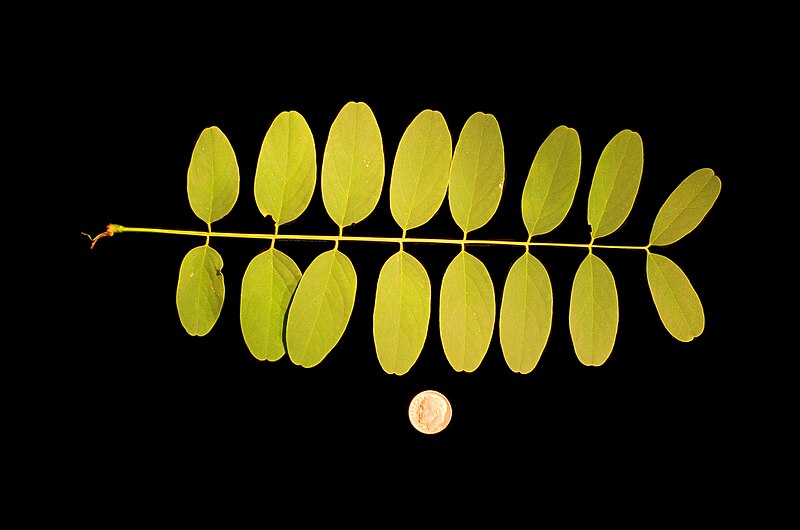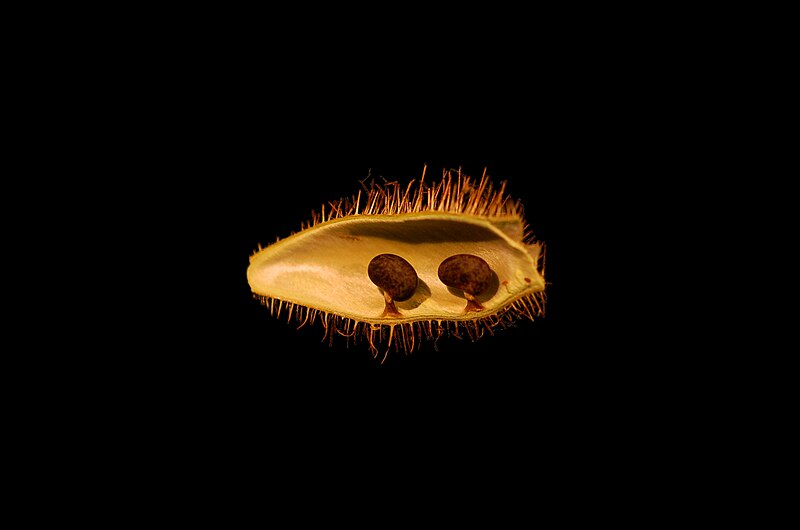Last year, as the deadline for my dissertation began to loom, lots of my personal projects got put on hold. A few weeks ago, when I went to Minneapolis for the 22nd North American Symbiotic Nitrogen Fixation Conference [1], I had lots of time on the bus. There was supposed to be wi-fi, but it was out more often than not. So I took the time to touch up some of the photos I've been meaning to upload to Wikimedia Commons.
These are various parts of the black locust tree (Robinia pseudoacacia). To give you an idea of how much cleanup can be required, the last row of photographs shows a "before" and "after". On the left you can see that the lighting I used gave the roots an unnatural yellow appearance and that the root nodules are difficult to make out. With the color adjusted the roots look white and the root nodules are noticeably pink, as they should be.
And here are some (but not all) of the same parts of a related species, the bristly locust (Robinia hispida var. fertilis). As you can see, it gets its name from the fact that its seed pods are substantially more bristly than those of Robinia pseudoacacia.
The bacterium streaked on this plate is called Janthinobacterium lividum. It's an interesting microbe that really deserves its own post. I added this image to the Wikipedia page for Janthinobacterium lividum.[2]
And lastly, this is Sinorhizobium meliloti that has been treated with a bacteriophage (a virus that infects bacteria) called ΦM12.[3] After the viruses multiply inside a bacterium, they pop it open so that the new viruses can go infect other bacteria. This creates little spots of dead bacteria, called plaques (the black dots in the picture above). I added this image to the Wikipedia page for Sinorhizobium meliloti.[4]
Notes:
[1] See my post 22nd NASNFC.
[2] See http://en.wikipedia.org/wiki/Janthinobacterium lividum.
[3] That first symbol is the Greek letter phi.
[4] See http://en.wikipedia.org/wiki/Sinorhizobium meliloti.
Image attributions:
ΦM12 plaques on Sinorhizobium meliloti is by Ninjatacoshell, available at http://commons.wikimedia.org/wiki/File:ΦM12 Plaques in Sinorhizobium meliloti.JPG.
Janthinobacterium lividum on an agar plate is by Ninjatacoshell, available at http://commons.wikimedia.org/wiki/File:Janthinobacterium lividum on TY.png.
Robinia hispida var. fertilis leaf is by Ninjatacoshell, available at http://commons.wikimedia.org/wiki/File:Robinia hispida var. fertilis leaf.JPG.
Robinia hispida var. fertilis open seed pod is by Ninjatacoshell, available at http://commons.wikimedia.org/wiki/File:Robinia hispida var. fertilis open pod with seeds.JPG.
Robinia hispida var. fertilis leaf is by Ninjatacoshell, available at http://commons.wikimedia.org/wiki/File:Robinia hispida var. fertilis pod.JPG.
Robinia hispida var. fertilis leaf is by Ninjatacoshell, available at http://commons.wikimedia.org/wiki/File:Robinia hispida var. fertilis seeds.JPG.
Robinia pseudoacacia leaf is by Ninjatacoshell, available at http://commons.wikimedia.org/wiki/File:Robinia pseudoacacia leaf.JPG.
Robinia pseudoacacia open seed pod is by Ninjatacoshell, available at http://commons.wikimedia.org/wiki/File:Robinia pseudoacacia open pod with seeds.JPG.
Robinia pseudoacacia seed pod is by Ninjatacoshell, available at http://commons.wikimedia.org/wiki/File:Robinia pseudoacacia seed pod 2.JPG.
Robinia pseudoacacia root nodules is by Ninjatacoshell, available at http://commons.wikimedia.org/wiki/File:Robinia pseudoacacia root nodules.JPG.
Robinia pseudoacacia root system is by Ninjatacoshell, available at http://commons.wikimedia.org/wiki/File:Robinia pseudoacacia root system.JPG.
Robinia pseudoacacia seeds is by Ninjatacoshell, available at http://commons.wikimedia.org/wiki/File:Robinia pseudoacacia seeds 2.JPG.
Robinia pseudoacacia open seed pod is by Ninjatacoshell, available at http://commons.wikimedia.org/wiki/File:Robinia pseudoacacia shoot.JPG.
These are various parts of the black locust tree (Robinia pseudoacacia). To give you an idea of how much cleanup can be required, the last row of photographs shows a "before" and "after". On the left you can see that the lighting I used gave the roots an unnatural yellow appearance and that the root nodules are difficult to make out. With the color adjusted the roots look white and the root nodules are noticeably pink, as they should be.
And here are some (but not all) of the same parts of a related species, the bristly locust (Robinia hispida var. fertilis). As you can see, it gets its name from the fact that its seed pods are substantially more bristly than those of Robinia pseudoacacia.
The bacterium streaked on this plate is called Janthinobacterium lividum. It's an interesting microbe that really deserves its own post. I added this image to the Wikipedia page for Janthinobacterium lividum.[2]
And lastly, this is Sinorhizobium meliloti that has been treated with a bacteriophage (a virus that infects bacteria) called ΦM12.[3] After the viruses multiply inside a bacterium, they pop it open so that the new viruses can go infect other bacteria. This creates little spots of dead bacteria, called plaques (the black dots in the picture above). I added this image to the Wikipedia page for Sinorhizobium meliloti.[4]
Notes:
[1] See my post 22nd NASNFC.
[2] See http://en.wikipedia.org/wiki/Janthinobacterium lividum.
[3] That first symbol is the Greek letter phi.
[4] See http://en.wikipedia.org/wiki/Sinorhizobium meliloti.
Image attributions:
ΦM12 plaques on Sinorhizobium meliloti is by Ninjatacoshell, available at http://commons.wikimedia.org/wiki/File:ΦM12 Plaques in Sinorhizobium meliloti.JPG.
Janthinobacterium lividum on an agar plate is by Ninjatacoshell, available at http://commons.wikimedia.org/wiki/File:Janthinobacterium lividum on TY.png.
Robinia hispida var. fertilis leaf is by Ninjatacoshell, available at http://commons.wikimedia.org/wiki/File:Robinia hispida var. fertilis leaf.JPG.
Robinia hispida var. fertilis open seed pod is by Ninjatacoshell, available at http://commons.wikimedia.org/wiki/File:Robinia hispida var. fertilis open pod with seeds.JPG.
Robinia hispida var. fertilis leaf is by Ninjatacoshell, available at http://commons.wikimedia.org/wiki/File:Robinia hispida var. fertilis pod.JPG.
Robinia hispida var. fertilis leaf is by Ninjatacoshell, available at http://commons.wikimedia.org/wiki/File:Robinia hispida var. fertilis seeds.JPG.
Robinia pseudoacacia leaf is by Ninjatacoshell, available at http://commons.wikimedia.org/wiki/File:Robinia pseudoacacia leaf.JPG.
Robinia pseudoacacia open seed pod is by Ninjatacoshell, available at http://commons.wikimedia.org/wiki/File:Robinia pseudoacacia open pod with seeds.JPG.
Robinia pseudoacacia seed pod is by Ninjatacoshell, available at http://commons.wikimedia.org/wiki/File:Robinia pseudoacacia seed pod 2.JPG.
Robinia pseudoacacia root nodules is by Ninjatacoshell, available at http://commons.wikimedia.org/wiki/File:Robinia pseudoacacia root nodules.JPG.
Robinia pseudoacacia root system is by Ninjatacoshell, available at http://commons.wikimedia.org/wiki/File:Robinia pseudoacacia root system.JPG.
Robinia pseudoacacia seeds is by Ninjatacoshell, available at http://commons.wikimedia.org/wiki/File:Robinia pseudoacacia seeds 2.JPG.
Robinia pseudoacacia open seed pod is by Ninjatacoshell, available at http://commons.wikimedia.org/wiki/File:Robinia pseudoacacia shoot.JPG.













No comments:
Post a Comment